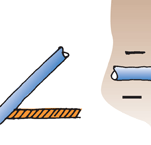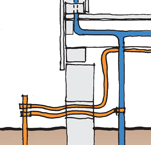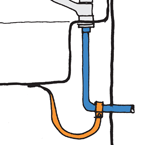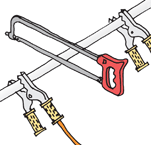Water
Water use, sustainability, and efficiency by choosing quality systems and materials, and providing environmentally friendly solutions.
Pipework installation
Pipes must be installed to meet requirements for durability, safety and thermal performance.
On this page:
- contractor responsibilities
- general installation requirements
- where to lay pipework
- access for maintenance and replacement
- preventing electric shock
- pipe insulation
Also see valves and controls for details of isolating valve requirements.
Responsibilities
Before a project starts, determine the responsibilities for specific work of the plumber, the main contractor and the electrician.
Discuss the location of pipe runs with the main contractor to minimise cutting or notching of framing.
General installation requirements
Pipework must:
- comply with the durability requirements of Building Code clause B2 Durability
- be compatible with the support
- be installed to allow for thermal movement
- be protected from freezing by insulation, or being buried below the level of freezing
- be protected from damage
- be wrapped in flexible material or sleeved when penetrating masonry or concrete.
Where to lay pipework
Pipework may be installed:
- in a roof space
- under a timber floor
- below a concrete slab (BRANZ does not recommend within slab installation).
Where pipes are buried, they must have:
- 600 mm cover under trafficked areas
- 450 mm cover under lawns and garden areas (non-trafficked)
Where pipes are under concrete, they must have 50-year durability.
Where pipes cross other services below ground, they must comply with the details shown in the following diagram.
Access for maintenance and replacement
Pipes installed in locations that are difficult to access should:
- have a detailed durability statement for 50-year service from the manufacturer
- if passing through a structural element, be sleeved in a larger pipe that is open at both ends to allow the pipe to be inspected or replaced if necessary
- be installed in a chase or duct which will provide ready access and will not compromise structural elements.
Preventing electric shock
Electric shock from water pipes may occur in any building where:
- the water supply piping is metal and in contact with the ground
- an electrical supply is provided into the building
- building occupants are able to make contact with exposed pipes.
To avoid the potential of electric shock:
- the pipework must be connected to an earth electrode using earth-bonding conductors
- metallic fixtures must be bonded to the pipework.
Safety precautions must be followed when cutting metal pipes.
Pipe insulation
NZBC Acceptable Solution G12/AS1 requires pipework to be insulated to:
- limit heat loss (hot water pipes)
- prevent water in pipes from freezing (hot and cold water pipes).
BRANZ recommends that all water pipes are insulated except where connected to a heat dissipation device. Use purpose-made, preformed insulation a minimum 13 mm thick. The Acceptable Solution H1/AS1 refers to NZS 4305:1996 Domestic type hot water systems, which requires the hot water pipe to a kitchen to be insulated.
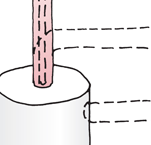
- Insulation of hot water distribution pipes
Although insulation of pipes is shown for a minimum 2 m from the storage water heater, BRANZ recommends insulating hot water pipes for their full length.
Updated: 05 November 2018


